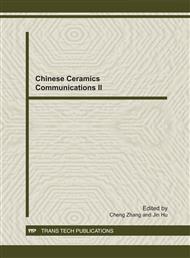p.263
p.267
p.271
p.275
p.280
p.285
p.290
p.294
p.298
Low Temperature Sintering and Microwave Dielectric Properties of Ba4Nd9.33Ti18O54 Ceramics Doped with Crystallizable Glass
Abstract:
The effect of CaO-B2O3-SiO2 glass on the densification, microstructure and microwave dielectric properties of Ba4Nd9.33Ti18O54 ceramics was investigated in this work. It was found that the addition of a few amount of glass (≤2%) could effectively decrease the sintering temperature owing to the viscous sintering. However, locally porous structures were formed when overmuch glass was added because of enwrapped air bubbles and rapid grain growth. In addition, the amount of remaining glass after sintering could be decreased due to the re-crystallization of CaO-B2O3-SiO2 glass. Sol-gel derived Ba4Nd9.33Ti18O54 ceramics containing 2 wt% glass can be well densified at 950°C and exhibit good microwave dielectric properties of εr=68 and Q×f=7400 GHz.
Info:
Periodical:
Pages:
280-284
Citation:
Online since:
November 2011
Authors:
Price:
Сopyright:
© 2012 Trans Tech Publications Ltd. All Rights Reserved
Share:
Citation:


